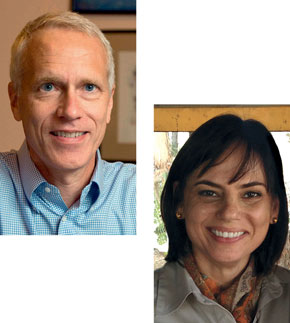 1 L.A. Cicero 2 Personal archive
1 L.A. Cicero 2 Personal archiveThe Nobel Laureate in Chemistry, Brian Kobilka, supported the research of Patricia Brum from USP1 L.A. Cicero 2 Personal archive
The announcement of the winners of the Nobel Prize in Chemistry, awarded in October 2012 to American scientists Robert Lefkowitz of Duke University and Brian Kobilka of Stanford University was cause for celebration for one Brazilian researcher who has a productive research collaboration with Kobilka. Patricia Chakur Brum, professor at the School of Physical Education and Sports and researcher at the Cellular and Molecular Physiology of Exercise Laboratory at the University of São Paulo (USP), did post-doctoral research at Stanford between 1999 and 2001 as a member of Kobilka’s group through a research grant from FAPESP. Between 2003 and 2007, she also received his support for her project conducted under FAPESP’s Young Investigators in Emerging Centers program. It was Kobilka who supplied the knockout mice for the adrenergic receptors that Brum used in her research into how sympathetic nervous hyperactivity contributes to cardiac insufficiency (see Pesquisa FAPESP Issue No. 79). She used mice with gene inactivation of the two receptors that regulate the heart beat – alpha 2a and alpha 2c adrenergic receptors. The knockout mice exhibited sympathetic hyperactivity similar to that seen in humans, which led to severe cardiac insufficiency and a 50% mortality rate at 7 months of age. “Brian helped me a lot and I always visit him when I go to Stanford,” says Brum who, until September 2012, was one of the coordinators in FAPESP’s health sciences area. She is currently on sabbatical at the Norwegian University of Science and Technology. The Nobel Prize recognized the work with G-protein-coupled receptors, which allow the body to sense its surroundings and adapt to new circumstances. In 1970, Lefkowitz discovered the first receptor of this type. In the decade that followed, he began to search for the gene responsible for building this receptor and hired the young Brian Kobilka to help him.
Republish
